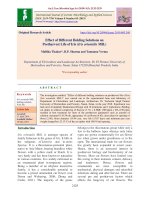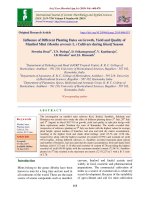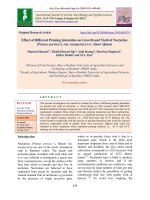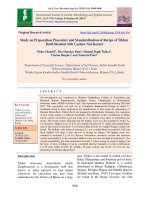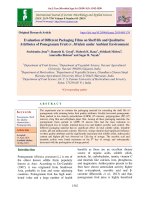Standardization of drying methods of different fruit types on storability of chilli seed
Bạn đang xem bản rút gọn của tài liệu. Xem và tải ngay bản đầy đủ của tài liệu tại đây (173.58 KB, 9 trang )
Int.J.Curr.Microbiol.App.Sci (2019) 8(10): 772-780
International Journal of Current Microbiology and Applied Sciences
ISSN: 2319-7706 Volume 8 Number 10 (2019)
Journal homepage:
Original Research Article
/>
Standardization of Drying Methods of different Fruit Types
on Storability of Chilli Seed
Chakradhar Patra1*, Laxmipriya Sahoo2, Saroj Kumar Mohanty1
and Monalisha Sahoo1
1
Department of Seed Science & Technology, College of Agriculture, Orissa University of
Agriculture and Technology, Bhubaneswar, Odisha, India
2
ICAR-Central Institute of Women in Agriculture, Bhubaneswar, India
*Corresponding author
ABSTRACT
Keywords
Chilli (Capsicum
annuum L.),
Fleshiness index,
Drying methods,
Germination
percentage
Article Info
Accepted:
07 September 2019
Available Online:
10 October 2019
The effect of seed drying methods on storability for chilli of different fruit types
was studied in Completely Randomized Design (CRD) in four replications with
five treatments. The chilli fruits were grouped like slender, moderate and fleshy as
per the fleshiness index and are exposed to different drying methods such as sundrying, shade drying, freeze drying, oven drying of fruits and hand extracted seeds
on the day of harvest followed by shade drying. Seeds were stored for 10 months
and observations were recorded on germination percentage, vigour index in a
regular interval of 2 months. Results revealed that fleshy fruit types showed
highest germination percentage in shade drying after 2 months of storage
(79.14%) & reduced gradually whereas lowest found in freeze drying method after
10 months after storage (12.26%) followed by medium and slender fruit types.
After 2 months of storage, shade dried fleshy fruit types of chilli exhibited highest
vigour index (943.553) followed by slender & medium fruit types whereas lowest
vigour index found in freeze dried slender fruit types of chilli after 10 months of
storage (50.99). Hence both shade drying and hand extracted seeds on the day of
harvesting is recommended for drying of chilli seeds.
Introduction
Chiili (Capsicum annuum L.; 2N=24) is a
member of the Solanaceae family. Nearly 30
species
were
identified
under
the
genus Capsicum. Out of it, only five species
C. annuum L., C. baccatum L.; C. chinense
Jacq.; C. frutescens L. and C. pubescens Ruiz
&Pavonand are mostly cultivated and are
recognized by International Bureau of Plant
Genetic Resources. Among all, C. annuum L.
is the widely cultivated and most explored
species. It is an indispensable spice essentially
used in every Indian cuisine due to its
772
Int.J.Curr.Microbiol.App.Sci (2019) 8(10): 772-780
pungency, taste, appealing colour and flavour.
Pungency of chilli is due to a crystalline acrid
volatile alkaloid called ‘capsaicin’, present in
the placenta of fruit which has diverse
prophylactic and therapeutic uses in allopathic
and ayurvedic medicine.
drying, freeze drying, oven drying of chilli
with fruits harvested at physiological maturity
and hand extraction of seeds on the day of
harvest followed by shade drying for
identifying suitable drying methods.
Materials and Methods
Chilli seeds exhibit peculiar behavior in
storage requirement. These seeds loose
viability quickly after being removed from
fruit. Seeds maintain viability for a longer
period when they are in fruits than the seeds
extracted and stored.
Seeds reported to maintain a higher
germination value up to 6 months, when
retained in fruits and stored under ambient
conditions (RadheSham et al., 1996; Nagaraja
et al., 1998b; Sahoo, 2014).
The quality of chilli seeds can be maintained
for a long period by adopting different drying
methods and also extraction methods.
Chilli, unlike brinjal and tomato, the other
members of Solanceae family where seeds are
mostly extracted at ripened stage using
fermentation method, chilli seed extraction is
mostly done after drying of the ripened fruits.
However it is reported that chilli seeds express
maximum vigour at physiological maturity
stage (Sahoo, 2014).
Hence chilli drying is very crucial from seed
viability and vigour point of view, as seeds
extracted from fruits at physiological maturity
is supposed to express maximum vigour.
So for understanding the viability and vigour
of chilli seeds, both inside the fruit and
extracted at the day of harvest for the entire
storage period is a matter of study.
Categorization of fruit types in chilli
genotypes using fleshiness index
Chilli fruits were categorized into three types
based on their shape characteristics and drying
requirements for standardization of drying
time, method and storage potential in ambient
condition and their effect on seed viability and
vigour.
A fleshiness index was developed for this
study to categorize different chilli fruit types.
The indicators used were the fruit shape (ratio
of fruit width and length) and fleshiness
(Pericarp thickness). This index is useful in
estimating indirectly the fruit cavity volume,
which in turn affects the total heat absorption
and retention by the fruit, deciding the seed
life in terms of viability and vigour during and
after drying.
Fleshiness index
Fleshiness index is a characteristic of both
Fruit Shape (Ratio of fruit width and length)
Fleshiness (Pericarp thickness)
Fleshiness Index = (Ratio of fruit width and
length) × Pericarp thickness
FI = (W/L) × P
Where FI = Fleshiness Index
Keeping these propositions in mind, the
present experiment was designed to evaluate
the drying methods like shade drying, sun-
W= Width of the fruit at the widest point
773
Int.J.Curr.Microbiol.App.Sci (2019) 8(10): 772-780
L = Fruit length excluding the stalk
Seed quality attributes studied
P = Pericarp thickness
Germination percentage
For this experiment the varieties were
categorized in to three groups based on the
range of the Fleshiness Index
The germination test was carried out using
germination papers by the between paper (BP)
method (ISTA, 1965) for all the stages. Four
such settings for four replications of fruit
types of chilli were placed in a germination
chamber at 25±10C in an upright position. The
final count was taken on 14th day and
germination (%)was calculated as percentage
of number of normal seedlings divided by no
of seeds used for germination test. Separate
observations were recorded for different
treatments.
Slender fruit type (i.e. FI = 0-0.3)
Medium fruit type (i.e. FI = 0.3-0.6)
Fleshy fruit type (i.e. FI > 0.6)
Seed quality attributes in different fruit
types with respect to drying and storage
condition
Seed Vigour Index (SVI)
For studying the effect of fruit types and
drying method on storage potential, 26
treatments were taken including control
wherein the genotypes were exposed to 5
drying methods and 5 storage durations.
M1 :
M2 :
M3 :
M4 :
M5:
Shade
Drying
Hand
Extracted
Sundried
Freeze
Drying
Oven Drying
Vigour index was determined for the stages
where only germination took place following
Abdul-Baki and Anderson, 1973.
Vigour index (VI)= Avg. length of seedlings
(cm) × Germination (%)
D1 :
2 Months
D2 :
4 Months
D3 :
6 Months
Standardisation of drying method
D4 :
8 Months
D5 :
10
Months
Standardization of drying methods of chilli
was done with fruits harvested at
physiological maturity. Methods used for
drying chilli are shade drying, sun drying,
freeze drying and oven drying. Besides above
treatments another was hand extraction of
seeds on the day of harvest followed by shade
drying.
Results and Discussion
Chilli of different fruit types were exposed to
5 types of drying methods. Harvested fruits
were dried under shade, sun, freeze and oven.
Some seeds were extracted manually from the
fruits on theday of harvest, washed thoroughly
and dried in shade for 2 days and in the sun
for 3 days for drying. After drying seeds were
stored on air-tight steel container, germination
and vigour testing was done at an interval of 2
months.
All the 27 studied genotypes of chilli
exhibited varying fruit types differing
significantly in fruit size, shape, weight and
fruit cavity with different pericarp thickness
were grouped in to three categories like
slender fruit type, medium fruit type and
fleshy fruit type using the value of fleshiness
774
Int.J.Curr.Microbiol.App.Sci (2019) 8(10): 772-780
index and subjected to different treatments as
dried fruits are the main source for seed
extraction. The dried fruits and seeds of all
treatments were subjected to ambient storage
condition packed in polythene in sealed
container and using destructive sampling.
Germination percentage
In the category of fleshy fruit type the average
germination percentage of chilli seed was
found highest in shade drying method
(79.139%) followed by hand extracted seed
(77.292) and lowest in freeze drying method
(56.569%) after 2 months of storage. The
shade dried fruits had a relative advantage
over sun-drying, freeze drying and oven
drying with general germination of 22.416%,
36.633%, 4.019% respectively. After 4
months of storage, highest germination
percentage was found in shade dried seed
(71.028%) followed by oven dried seed
(70.111%) and hand extracted seed (69.694%)
however germination capacity was similar
between oven dried and hand extracted seed
and lowest was found in freeze dried seed
(52.278%). After 4 months of storage, the
relative advantage of shade dried fruits over
sun-drying, freeze-drying and oven drying
were 20.899%, 35.866 % and 1.308%. After 6
months of storage, the trend as like as 4
months after storage was observed. But after 8
and 10 months after storage, hand extracted
seeds had shown the highest germination
percentage than that of other drying methods
i.e. 55.250% and 33.250% respectively. In the
category of medium fleshy type of fruit, the
highest germination was found in hand
extracted seed (75.556%) followed by shade
dried seed (73.986%) and lowest in freeze
dried seed (56.847%) after 2 months of
storage. The shade dried fruits had relative
advantage over sun-drying, freeze drying and
oven drying were 18.484%, 30.149% and
2.363% respectively.
This trend was followed in the seed after 4
months of storage and 6 months of storage and
the shade dried fruits had relative advantage
over sun-drying, freeze drying and oven
drying were 18.569%, 31.359%, 0.041% and
32.220%, 48.552%, 0.533% respectively. But
after 8 and 10 months of storage, hand
extracted seeds had highest germination
percentage followed by shade dried seed the
shade dried fruits had relative advantage over
sun-drying, freeze drying and oven drying
were 22.914%, 74.524%, -14.523% and
24.456%, 139.792%, -8.980% respectively.
In the category of slender type of fruit, the
highest germination was found in hand
extracted seed (73.478%) followed by shade
dried seed (72.156%) and lowest in freeze
dried seed (57.122%) after 2 months of
storage. The shade dried fruits had relative
advantage over sun-drying, freeze drying and
oven drying were 16.631%, 26.319% and
1.899% respectively. This trend was followed
in the seed after 4, 8 and 10 months of storage
and the shade dried fruits had relative
advantage over sun-drying, freeze drying and
oven drying were 16.932%, 29.065%, 1.210% (4 months after storage), 19.097%,
73.732%, -14.579% (8 months after storage)
and 10.583%, 134.085%, -9.359 (10 months
after storage). But after 6 months of storage,
shade dried seeds had highest germination
percentage (65.211%) followed by hand
extracted seed (64.656%) and the shade dried
fruits had relative advantage over sun-drying,
freeze drying and oven drying were 29.472%,
47.240%, -0.862% after 6 months of storage.
In most of the cases like shade dried seed,
hand extracted seed, sun dried seed and oven
dried seed showed more germination
percentage in fleshy fruit type in compared to
medium and slender type of fruit, but in freeze
dried seed, the slender type of fruit showed
maximum germination percentage followed by
medium and fleshy fruit type (Fig. 1 and 2;
Table 1–3).
775
Int.J.Curr.Microbiol.App.Sci (2019) 8(10): 772-780
Table.1 Different fruit types in chilli genotypes based on fleshiness index
Fruit Type
Slender
Landraces
V7, V8, V9, V10, V11, V12, V14, V15,
V16, V17, V19, V20, V21,V23,V27
% of total samples
55.6%
Medium
V2, V3, V4, V5, V18, V22
22.2%
Fleshy
V1, V6, V13, V24, V25, V26
22.2%
Table.2 Seed germination percentage of chilli (Capsicum annuum L.) dried under different
conditions in ambient storage
Drying methods & Storage duration combination
M0D0 (Contol)
M1D1 ( Shade Dried+ stored for 2 Months)
M1D2 ( Shade Dried+ stored for 4 Months)
M1D3 ( Shade Dried+ stored for 6 Months)
M1D4 ( Shade Dried+ stored for 8 Months)
M1D5 ( Shade Dried+ stored for 10 Months)
M2D1 ( Hand Extracted + stored for 2 Months)
M2D2 ( Hand Extracted + stored for 4 Months)
M2D3 ( Hand Extracted + stored for 6 Months)
M2D4 ( Hand Extracted + stored for 8 Months)
M2D5 ( Hand Extracted + stored for 10 Months)
M3D1 ( Sundried+ stored for 2 Months)
M3D2 ( Sundried+ stored for 4 Months)
M3D3 (Sundried+ stored for 6 Months)
M3D4 ( Sundried+ stored for 8 Months)
M3D5 (Sundried+ stored for 10 Months)
M4D1 (Freeze Dried+ stored for 2 Months)
M4D2 (Freeze Dried+ stored for 4 Months)
M4D3 (Freeze Dried+ stored for 6Months)
M4D4 (Freeze Dried + stored for 8Months)
M4D5 (Freeze Dried + stored for 10Months)
M5D1( Oven Dried + stored for 2Months)
M5D2 ( Oven Dried + stored for 4Months)
M5D3 ( Oven Dried + stored for 6 Months)
M5D4 ( Oven Dried + stored for 8 Months)
M5D5 ( Oven Dried + stored for 10Months)
SE(m)
CD(0.05%)
CD(0.01%)
CV%
776
Germination % Mean
Slender
Medium
77.056
78.083
73.478
75.556
67.989
69.000
65.211
65.486
49.611
48.722
32.278
31.806
72.156
73.986
68.178
68.972
64.656
64.667
55.511
53.889
32.767
32.472
61.867
62.444
58.144
58.194
50.367
49.528
41.656
39.639
29.189
25.556
57.122
56.847
52.678
52.528
44.289
44.083
28.556
27.917
13.789
13.264
70.811
72.278
68.822
68.972
65.778
65.139
58.078
57.000
35.611
34.944
0.315
0.366
0.896
1.041
1.190
1.382
1.02
1.19
Fleshy
82.444
79.139
71.028
66.181
48.917
32.333
77.292
69.694
65.222
55.250
33.250
63.139
58.750
50.472
39.500
24.250
56.569
52.278
44.028
26.556
12.264
74.306
70.111
66.167
58.056
35.389
0.326
0.928
1.233
1.04
Int.J.Curr.Microbiol.App.Sci (2019) 8(10): 772-780
Methods of Drying
M1 :
Shade Dried
M2 :
Hand Extracted
M3 :
Sundried
M4 :
Freeze Dried
M5:
Oven Dried
Duration of Storage after drying
D1 :
2 Months
D2 :
4 Months
D3 :
6 Months
D4 :
8 Months
D5 :
10 Months
Table.3 Seed Vigour index of chilli (Capsicum annuum L.) dried under different conditions in
ambient storage
Drying methods & Storage duration combination
M1D1 ( Shade Dried+ stored for 2 Months)
M1D2 ( Shade Dried+ stored for 4 Months)
M1D3 ( Shade Dried+ stored for 6 Months)
M1D4 ( Shade Dried+ stored for 8 Months)
M1D5 ( Shade Dried+ stored for 10 Months)
M2D1 ( Hand Extracted + stored for 2 Months)
M2D2 ( Hand Extracted + stored for 4 Months)
M2D3 ( Hand Extracted + stored for 6 Months)
M2D4 ( Hand Extracted + stored for 8 Months)
M2D5 ( Hand Extracted + stored for 10 Months)
M3D1 ( Sundried + stored for 2 Months)
M3D2 ( Sundried + stored for 4 Months)
M3D3 (Sundried + stored for 6 Months)
M3D4 ( Sundried + stored for 8 Months)
M3D5 (Sundried + stored for 10 Months)
M4D1 (Freeze Dried + stored for 2 Months)
M4D2 (Freeze Dried + stored for 4 Months)
M4D3 (Freeze Dried + stored for 6Months)
M4D4 (Freeze Dried + stored for 8Months)
M4D5 (Freeze Dried + stored for 10Months)
M5D1( Oven Dried + stored for 2Months)
M5D2 ( Oven Dried + stored for 4Months)
M5D3 ( Oven Dried + stored for 6 Months)
M5D4 ( Oven Dried + stored for 8 Months)
M5D5 ( Oven Dried + stored for 10Months)
SE(m)
CD(0.05%)
CD(0.01%)
CV%
777
Vigour Index Mean
Slender
Medium
Fleshy
922.169
1020.203 1099.250
842.787
810.631
943.553
718.669
878.325
856.436
662.957
727.190
851.451
381.657
449.839
558.292
266.831
282.022
281.504
724.270
863.394
532.810
808.473
749.783
656.697
655.222
653.150
686.001
475.247
499.408
581.600
239.200
203.331
192.356
556.887
636.475
578.763
517.317
531.406
489.619
401.426
475.419
485.298
299.453
286.792
325.976
156.088
143.472
137.182
485.506
419.044
423.860
333.954
420.681
415.939
308.618
368.692
315.208
162.880
161.661
175.949
50.990
73.992
62.300
757.991
667.458
847.258
751.821
733.725
797.347
666.490
649.433
738.350
492.062
414.511
562.206
273.590
293.656
298.333
26.057
44.667
42.469
74.058
126.949
120.702
98.375
168.633
160.335
Int.J.Curr.Microbiol.App.Sci (2019) 8(10): 772-780
Fig.1 Seed germination percentage of chilli (Capsicum annuum L.) dried under different
conditions and stored for different durations
Fig.2 Vigour index of chilli (Capsicum annuum L.) dried under different conditions and stored
for different durations
Vigour index
In the category of fleshy fruit type, shade
dried seeds had highest vigour index
(943.553) followed by oven dried seeds
(847.258) and sundried seeds (578.763) and
lowest in freeze dried seeds (423.860) after 2
months of storage. This same trend was
observed in seeds after 4 and 6 months after
storage. But after 8 months of storage, highest
vigour index observed in hand extracted seed
(581.600) followed by oven dried seed
(562.206) and shade dried seed (558.292) and
after 10 months of storage highest vigour
778
Int.J.Curr.Microbiol.App.Sci (2019) 8(10): 772-780
index found in oven dried seed (298.333)
followed by shade dried seed (281.504). In the
category of medium fleshy fruit type, hand
extracted seeds had highest vigour index
(863.394) followed by shade dried seeds
(810.631) and oven dried seeds (667.458) and
lowest in freeze dried seeds (419.044) after 2
months of storage and this same trend was
observed in seeds after 8 months of storage.
But after 4 and 6 months of storage highest
vigour index observed in shade dried seed
(878.325 and 727.190 respectively) followed
by hand extracted seed (749.783 and 653.150
respectively) and after 10 months of storage
highest vigour index found in oven dried seed
(293.656) followed by shade dried seed
(282.022). In the category of slender fruit
type, shade dried seeds had highest vigour
index (842.787) followed by oven dried seeds
(757.991) and hand extracted seeds (724.270)
and lowest in freeze dried seeds (485.506)
after 2 months of storage and this same trend
was observed in seeds after 4 months of
storage.
Drying methods and fleshiness index played
very important role in seed quality in the
present experiment. Results can be better
interpreted by understanding the fact that,
chilli seed attains physiological and functional
maturity at high seed moisture content of 3940% and the rate of moisture migration from
center to surface of the seed is influenced by
temperature, pericarp thickness, chemical
composition of seed and seed coat
permeability. The rate of moisture removal
from the surface of seed is influenced by
degree of surface saturation, thickness of the
pericarp or fleshiness of the fruit, relative
humidity and temperature of drying air. If
evaporation from the seed surface occurs too
rapidly it can damage the embryo, therefore
seed should be dried carefully to arrest stress
damage due to heat. In contrast, if moisture
elimination takes place too slowly it may
favour invasion of pathogens (Harrington,
1972). In the present experiment shade drying
of chilli fruits harvested at red maturity or
physiological maturity was found to be the
most effective method of drying in all the
three types of fruit i.e. slender, medium and
fleshy. Seeds extracted and shade dried on the
day of harvest was also effective for a certain
period in all fruit types (Patraet al., 2016). Sun
drying was less effective for seed purpose.
Similar results were reported by Thiagarajan
(1983) in chillies.
These results are in agreement with the
findings of Dhanelappagol et al., (1988) in
chillies, Javaregowda et al., (1990) in tomato
and Shivahre et al., (1995) in chillies. Heat
tolerance of seed varies with the species. For
drying of vegetable seed, temperature not
exceeding 350C has been advocated by
Harrington (1972).This variation in seed
quality parameters among different fruit types
may be due to existence of variability and
storability for different duration of storage.
Drying requirements of chilli seed was found
to be very peculiar and depends on thickness
of the pericarp or fleshiness index, type of
fruits in a view to get good quality of chilli
seeds along with it plays an important role in
storability of chilli seeds. The present
experiment evaluated all these aspects and
revealed that shade drying of chilli fruits
harvested at physiological maturity or seeds
extracted on the same day of harvest followed
by shade drying are useful for maintaining
seed viability and vigour up to 6 months
duration of safe storage. After that, its quality
got drastically reduced in all fruit types of
chilli such as slender, medium and fleshy.
References
Abdul Baki, A.A., Anderson J.D., 1973, Vigor
determination in soybean by multiple
criteria. Crop Sci., 13: 630-633.
Barua H., Rahman M.M., Masud M.M. 2009,
779
Int.J.Curr.Microbiol.App.Sci (2019) 8(10): 772-780
Effect of storage containers environment
at different storage period on the quality
of chilli seed. International Journal on
Sustain Crop Production 4(4):28-32.
Bellad S., 1997, Effect of exhaustion and drying
methods on quality of potato seed
(Solanum tuberosum L.) M.Sc. (Agril)
thesis, University of Agricultural
Sciences, Dharwad.
Cavero J., Ortega R.G., 1995, Influence of fruit
ripeness at the time of seed extraction on
pepper (Capsicum annuum L.) seed
germination. Scientia Horticulture, 60(34):345-352
Christensen C.M., Kaufman C.M., 1965,
Deterioration of stored grains by fungi.
Annual Review of Phytopathology,
3:69-84.
Copeland L.O., 1976, Principles of Seed Science
and Technology, Burgess Publication
Co., Minnessot.
Dhanelappagol, M. S., Shashidhara, S. D.,
Kulkarni, G.N., 1988, Studies on drying
characteristics of chillies. Journal of
Agricultural Engineering, 25: 72-75.
Harrington J.F. 1972, Seed storage and
longevity. In Seed Biology, 3: 145-245.
Javaregowda S., Talukdar K.C., Ramaih H.,
1990, Effect of drying methods on seed
quality in tomato. Seed Research, 18:
126-1629.
Nagaraja A., Basavaraja P.K., Yogeesha H.S.,
1998, Effect of drying methods on fruit
and seed quality of chilli. South Indian
Horticulture, 46(3/6): 262-265
Patil K.N., Nagaraja A., 1999, Effect of storage
methods on quality of chilli seeds.
Karnataka Journal of Agricultural
Sciences, 12(1/4): 74-80
Patra C., Sahoo L.P., Sasamala A.C. and
Mohanty S.K. 2016. Studying the effect
of different fruit and seed drying
methods on seed quality of two different
genotypes of chilli (Capsicum annuum
L.). International Journal of Science,
Environment and Technology, 5(5):
3262-3270
RadheShyam, Arora S.K., Tomer R.P.S., 1996,
Effect of seed extraction interval on seed
quality of chilli (Capsicum annuum L.)
cultivars.
Haryana
Agricultural
University Journal of Research, 26(3):
183-186
Sahoo L.P., 2014, fruit and seed development
pattern and seed storability of some
genotypes of chilli (Capsicum annuum
L.). Ph.D. thesis, Department of Seed
Science and Technology, Orissa
University of Agriculture & Technology,
Bhubaneswar, Odisha, India.
Shivahre V.S., Singh B.P., Saxena RP, 1995,
Drying characteristic of chillies. Phala
Samskarana, 19: 401-407
Thiagarajan, L. P., 1983, Studies on certain
aspects of production, processing and
storage of chilli (Capsicum annuum L.)
seed. Ph.D. thesis, Tamil Nadu
Agricultural University, Coimbatore.
Vinod Kumar, 1998, Effect of stage of
harvesting and drying methods on seed
quality of paprika chilli (Capsicum
annuum L.), M. Sc. (Agril.) thesis,
University of Agricultural Sciences,
Dharwad.
How to cite this article:
Chakradhar Patra, Laxmipriya Sahoo, Saroj Kumar Mohanty and Monalisha Sahoo. 2019.
Standardization of Drying Methods of different Fruit Types on Storability of Chilli Seed.
Int.J.Curr.Microbiol.App.Sci. 8(10): 772-780. doi: />
780

